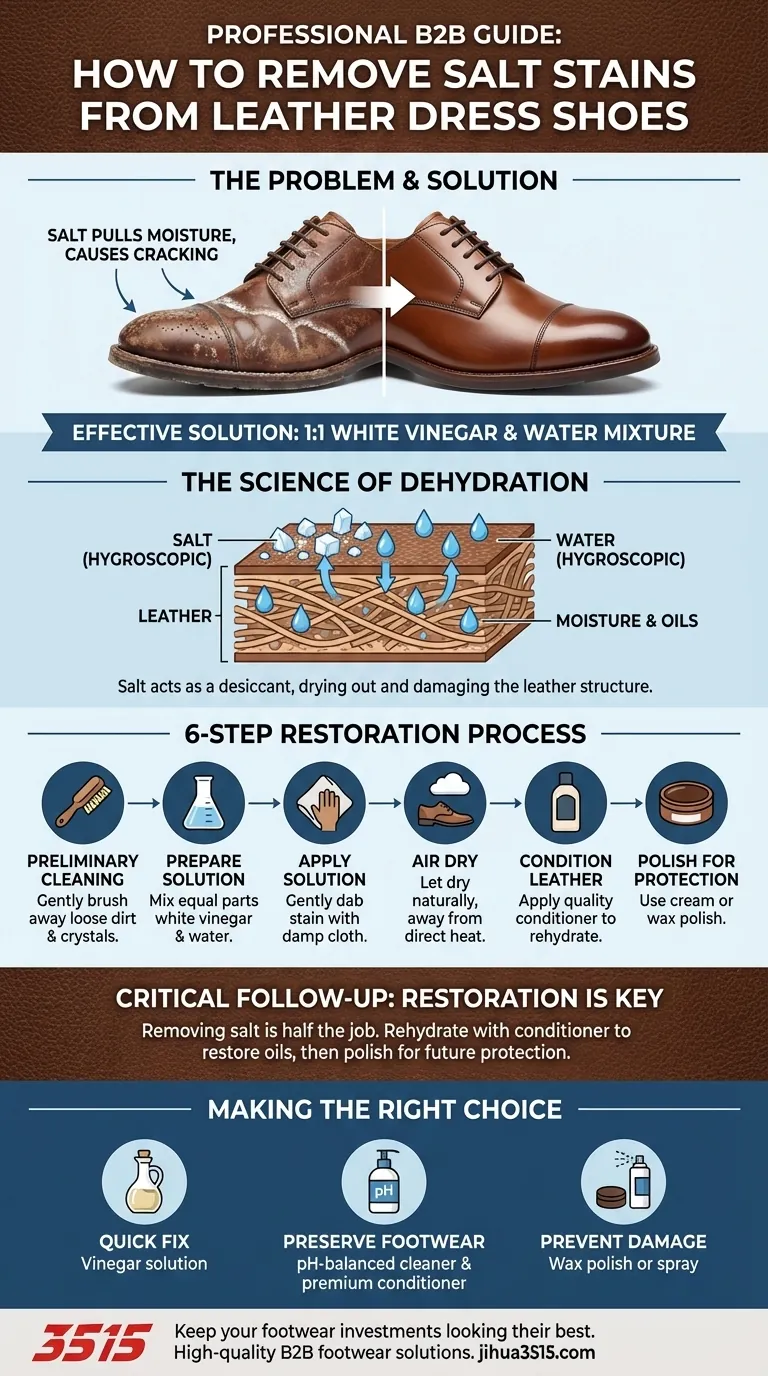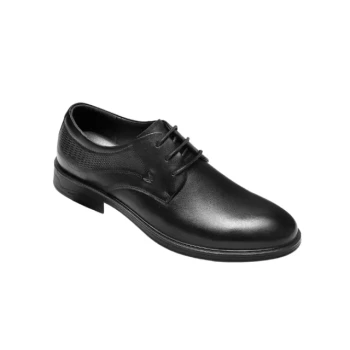To remove salt stains from leather dress shoes, you don't need expensive products. The most effective solution is a simple mixture of equal parts white vinegar and water, which gently dissolves and lifts the salt deposits without oversaturating the leather.
The key to saving your leather shoes is understanding that salt doesn't just sit on the surface; it actively pulls moisture out of the hide. Therefore, a successful treatment always involves two distinct phases: carefully removing the salt stain, then immediately reconditioning the leather to restore its essential oils.

Why Salt is So Damaging to Leather
Salt stains are more than a cosmetic issue; they represent a direct threat to the integrity of your shoes. Understanding the mechanism of damage helps clarify why the right cleaning process is so critical.
The Science of Dehydration
Leather is a porous, natural material that contains oils and moisture, which keep it flexible and durable. Salt is hygroscopic, meaning it attracts and absorbs water molecules from its environment.
When salt residue sits on your shoes, it relentlessly pulls those essential oils and moisture out of the leather. This process is what causes the material to dry out, become brittle, and eventually crack.
The Visible "Tideline"
The white stain you see is the mineral deposit left behind after the snow or slush has evaporated. This "tideline" marks the area where the leather has been most severely dehydrated, making it the most vulnerable to permanent damage.
The Step-by-Step Removal and Restoration Process
Follow these steps precisely to remove the stain and ensure the long-term health of your footwear. Rushing the process or skipping steps can lead to worse damage.
Step 1: Preliminary Cleaning
Before addressing the stain itself, you must remove any loose contaminants. Use a soft horsehair brush or a clean, lint-free cloth to gently brush away any surface-level dirt, dust, and dried salt crystals. This prevents you from grinding abrasive particles into the leather in the next step.
Step 2: The Cleaning Solution
Create a solution of one part white vinegar to one part water. This gentle acidic mixture is perfect for breaking down the alkaline salt deposits without being harsh on the leather. While some suggest using spit, the vinegar solution offers more consistent and predictable results.
Step 3: Gentle Application
Dip a clean, soft cloth into the solution, wringing it out so it is damp, not dripping wet. Gently wipe the stained areas. Use a dabbing motion or light circular strokes, focusing only on the salt lines. You should see the white stains begin to dissolve and disappear.
Step 4: Air Drying Correctly
Once the stains are gone, wipe the entire shoe with a separate, slightly damp cloth to blend the area and prevent water spots. Then, let the shoes air dry completely at room temperature. Never place them near a radiator, vent, or other direct heat source, as this will cause the leather to shrink and crack.
The Critical Follow-Up: Restoring the Leather
Removing the salt is only half the job. The cleaning process, along with the salt itself, has stripped the leather of its natural oils. This next phase is non-negotiable.
Conditioning to Rehydrate
Once the shoes are fully dry, apply a quality leather conditioner. Place a small amount on a clean cloth and work it into the leather using small, circular motions. This replenishes the oils, restores flexibility, and revives the color of the shoe.
Polishing for Protection
After the conditioner has been absorbed, apply a cream or wax polish that matches your shoe color. This final step adds a layer of protection against future moisture and salt exposure while also restoring the shoe's characteristic shine.
Making the Right Choice for Your Shoes
Your approach should be guided by your goal, whether it's a quick fix or long-term preservation.
- If your primary focus is a quick and effective fix: The 1:1 white vinegar and water solution is the most reliable and accessible method for removing fresh salt stains.
- If your primary focus is preserving expensive footwear: Invest in a dedicated pH-balanced leather cleaner and a premium conditioner to ensure the most gentle and restorative treatment.
- If your primary focus is preventing future damage: Regularly apply a protective wax polish or a weather-proofing spray before the winter season begins to create a barrier against salt and water.
Proper care is what transforms a simple pair of shoes into a lasting investment.
Summary Table:
| Step | Action | Key Detail |
|---|---|---|
| 1 | Preliminary Cleaning | Brush away loose dirt and salt crystals. |
| 2 | Prepare Solution | Mix equal parts white vinegar and water. |
| 3 | Apply Solution | Gently dab the stain with a damp cloth. |
| 4 | Air Dry | Let shoes dry naturally away from heat. |
| 5 | Condition Leather | Apply a quality leather conditioner. |
| 6 | Polish | Use cream or wax polish for protection. |
Keep your footwear investments looking their best. As a large-scale manufacturer, 3515 produces a comprehensive range of durable leather footwear for distributors, brand owners, and bulk clients. Our production capabilities ensure high-quality shoes and boots built to last. Contact us today to discuss your footwear needs and discover how we can add value to your business.
Visual Guide

Related Products
- Custom Manufactured Air Cushion Leather Business Shoes for Wholesale
- Factory Direct Wholesale Leather Comfort Shoes with Dial Closure
- Wholesale Leather Derby Shoes Manufacturer | Customizable Business & Dress Footwear
- Classic Leather Derby Dress Shoes Wholesale & Custom Manufacturing
- Wholesale Leather Business Casual Shoes with Dial Closure - Manufacturer of Comfort Dress Sneakers
People Also Ask
- What should be considered when choosing sneakers for a business casual office look? Achieve Comfort & Professionalism
- Why are sneakers now accepted in office environments? The Shift to Modern Professionalism
- What are the key features of high-quality leather in shoes? Invest in Durability and a Perfect Fit
- What are the characteristics of business casual sneakers? Master the Polished & Professional Look
- Can sneakers be part of a business casual wardrobe? Yes, with the right style and fit



















